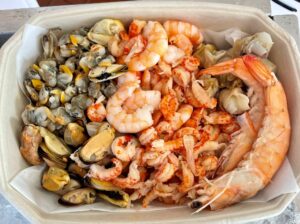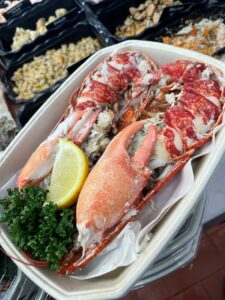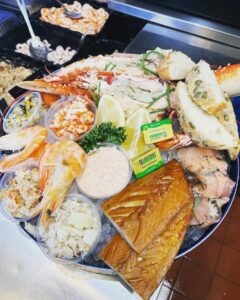That is the question. When you’re looking into getting a nice bit of Cornish haddock fillet, you can’t go wrong with The Cornish Fish Co! But what lies behind the scrumptious fish which we all know and love? Let’s take a closer look at what haddock is, facts about the haddock and finally if we can truly be friends with this wonderful species.
What is Haddock?
The almighty haddock is a species of fish within the Gadidae family. Don’t ask us how to pronounce it but some popular family members are cod, pollock, whiting and more. Haddock are important team members when it comes to commercial fisheries and local economies.
Is it easily distinguishable from its Gadidae family members? You bet it is! It has a pointed dorsal fin, which resembles that of a shark. It has dark-coloured scales on the upper portion of its body and lighter-coloured scales on its sides and underbelly.
Haddock Facts
Let’s dive into some haddock facts. Did you know that the largest recorded haddock was 37inches long and weighed 24lb?! That’s an extra-extra large order from your local fish and chip shop. These fish have interesting traits as well, here are three.
Fishery – Commercial fisheries target this species as a source of food. Because they live in similar habitats, fishermen often catch this species with whiting, cod, and other bottom-dwelling fish.
This Fish as Food – People prepare and sell the meat of this fish in a number of ways. You can buy this fish fresh, dried, frozen, or smoked. People compare the meat of this fish to the related cod.
Finnan Haddie – People often prepare this fish as “Finnan haddie,” which comes from the town of Finnan, Scotland. They cold-smoke the fish and then poach it in milk as a breakfast dish.
Haddock Habitat
Haddocks prefer demersal habitats, so you can usually find them near the bottom of the sea. You can mainly find them around the eastern coast of North America alongside the coasts of Europe. They’re much more commonly found in European waters, especially near the English Channel.
They don’t range into freshwater ecosystems and primarily live in saltwater. Most haddock will be at depths around 260ft deep but can live in waters as deep as 1,400ft! The diet of haddock can vary mainly due to their age or size. When they’re smaller, they need to feed on smaller prey such as plankton, krill, fish larvae and other tiny sources of food. As they get bigger they branch out into larger prey such as sand eels, herring, hake, capelin, worms, sea urchins and more.
Can we be friends?
Yes. Kind of. Humans interact with haddock frequently due to the haddock being a commercially fished species. Unfortunately, there is a downside to this. In some regions, overfishing has caused haddock to reach IUCN’s list of vulnerable species. When trawling, fishermen drag the nets along the bottom, scooping fish and damaging the habitat in the process.
We haven’t domesticated this species in any way nor would you want to. It grows too large to keep in a home aquarium. We would personally not put them into the top 10 fish to be friends with, regardless if cartoons say otherwise.







